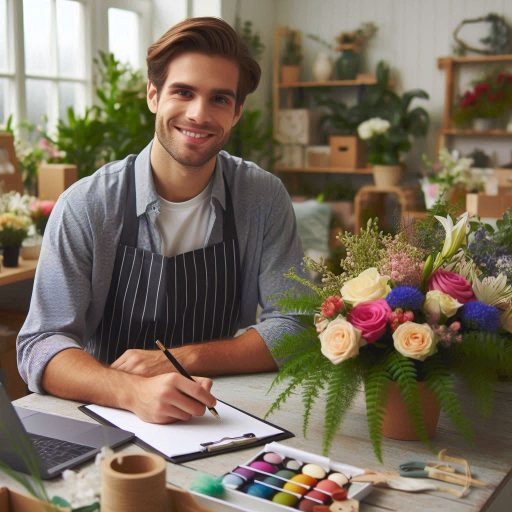Introduction
Floral design is a creative and artistic field that involves arranging flowers in aesthetically pleasing displays.
Technology has revolutionized various industries, including the floral design industry.
Online platforms have made it easier for floral designers to showcase their work and reach a wider audience.
Social media has become a powerful tool for marketing and promoting floral designs.
Design software allows floral designers to create virtual mock-ups of their arrangements before actually putting them together.
This saves time and resources, making the design process more efficient.
Technology has improved the supply chain management in the floral industry by providing real-time tracking of shipments and inventory.
This ensures that fresh flowers are delivered promptly to the designers.
E-commerce platforms have enabled customers to order flowers online, bypassing the traditional brick-and-mortar florist shops.
This convenience has changed the way customers purchase floral arrangements.
Technology has also played a role in promoting sustainable practices within the floral industry.
Designers are now able to source ethically-grown flowers and reduce waste through efficient inventory management systems.
Technology in Floral Arrangement
How technology is being used in creating unique and modern floral arrangements
In today’s fast-paced world, the floral design industry is not immune to the technological advancements that are shaping various sectors.
The use of technology in floral arrangement has revolutionized the way designers create stunning and innovative floral displays.
One of the most striking ways in which technology is being utilized in floral design is through the creation of unique and modern floral arrangements.
With the help of digital tools and software, designers can experiment with different colors, shapes, and textures to bring their creative visions to life in ways that were not possible before.
Use of 3D printing technology to design custom vases and containers
Moreover, the integration of 3D printing technology has further expanded the possibilities in floral design.
Designers can now leverage this cutting-edge technology to design and craft custom vases and containers that perfectly complement their floral creations.
This allows for a level of customization and personalization that was previously unheard of in the industry.
By harnessing the power of 3D printing, designers can create intricate and elaborate designs that add a touch of sophistication and elegance to their floral arrangements.
Transform Your Career Today
Unlock a personalized career strategy that drives real results. Get tailored advice and a roadmap designed just for you.
Start NowWhether it’s a delicate vase with intricate patterns or a modern container with a sleek finish, the possibilities are truly endless with this innovative technology.
Furthermore, 3D printing also offers a more sustainable and eco-friendly approach to floral design.
Designers can reduce waste by only producing the exact number of vases and containers they need, minimizing the environmental impact of their creations.
This aligns with the growing trend towards sustainability in the floral industry, making 3D printing an attractive option for designers looking to adopt more eco-conscious practices.
In essence, technology is playing a pivotal role in shaping the future of the floral design industry.
From creating unique and modern floral arrangements to leveraging 3D printing technology for custom vases and containers, designers are embracing technological advancements to push the boundaries of their creativity and craftsmanship.
The integration of technology has not only enhanced the aesthetic appeal of floral arrangements but has also opened up new opportunities for innovation and sustainability in the industry.
As technology continues to evolve, we can expect to see even more exciting developments that will further revolutionize the art of floral design.
Read: Career Opportunities for Floral Designers
Online Ordering and Delivery Services
Importance of online platforms in selling and delivering floral arrangements
With the advancement of technology, online ordering and delivery services have become essential components of the floral design industry.
The convenience and accessibility offered by online platforms have significantly changed the way customers purchase flowers.
Online platforms provide customers with a wide range of options when it comes to selecting and ordering floral arrangements.
They can browse through various designs, colors, and styles from the comfort of their homes or offices.
One of the main advantages of online ordering is the convenience it offers to customers.
They can place orders at any time of the day or night, without the need to visit a physical store.
This flexibility has made it easier for people with busy schedules to purchase flowers for special occasions.
Moreover, online platforms have made it possible for customers to send flowers to loved ones who are located in different cities or even countries.
This has strengthened the emotional connections between people separated by distance, allowing them to express their feelings through the beauty of flowers.
Rise of on-demand delivery services for same-day delivery
The rise of on-demand delivery services has further transformed the floral industry by providing customers with the option of same-day delivery.
Showcase Your Business Today
Reach thousands of readers actively exploring professional services. Publish your business profile and grow your audience now.
Publish NowThis level of convenience was previously unattainable, as traditional florists usually required advance notice for delivery.
On-demand delivery services have enabled customers to make spontaneous gestures or surprise loved ones with fresh flowers on the same day.
This immediacy has significantly increased the appeal of floral arrangements as gifts for various occasions, such as birthdays, anniversaries, and celebrations.
Furthermore, the efficiency of on-demand delivery services has enhanced customer satisfaction and loyalty.
Customers appreciate the speed and reliability of same-day delivery, which creates a positive shopping experience and encourages repeat purchases.
In fact, online ordering and delivery services have become integral to the floral design industry, providing customers with convenience, accessibility, and prompt delivery options.
The rise of on-demand delivery services has revolutionized the way people purchase and send flowers, making floral arrangements more accessible and appealing than ever before.
Read: Sustainable Floral Design: Eco-Friendly Practices
Use of Virtual Reality (VR) and Augmented Reality (AR)
In recent years, Virtual Reality (VR) and Augmented Reality (AR) have become integral tools in the floral design industry.
These innovative technologies are transforming the way designers create and showcase their arrangements, as well as how customers experience and interact with floral products.
Revolutionizing the Floral Design Process
VR and AR have revolutionized the traditional floral design process by allowing designers to create and manipulate virtual arrangements in three-dimensional space.
Designers can experiment with different floral combinations, colors, and styles without needing physical flowers, vases, or supplies.
This not only streamlines the design process but also opens up new creative possibilities.
Helping Customers Visualize Arrangements
One of the most significant benefits of VR and AR in the floral design industry is their ability to help customers visualize arrangements before making a purchase.
With VR technology, customers can virtually “try out” different bouquets or centerpieces in their desired space, whether it’s a wedding venue, event hall, or home.
This visual representation allows customers to make more informed decisions and ensures that the final product meets their expectations.
AR takes this a step further by overlaying digital flower arrangements onto real-life settings through a smartphone or tablet camera.
Customers can see how a particular arrangement would look on their dining table or in their living room before committing to a purchase.
This interactive experience enhances customer engagement and satisfaction, ultimately leading to more confident buying decisions.
Enhancing the Customer Experience
By incorporating VR and AR technologies into the floral design process, businesses can enhance the overall customer experience.
These immersive technologies provide a more personalized and interactive shopping experience, allowing customers to engage with products in a way that was previously impossible.
Customers feel more connected to the products they are considering purchasing, leading to increased brand loyalty and repeat business.
Driving Innovation and Creativity
VR and AR have also sparked innovation and creativity in the floral design industry.
Designers are exploring new ways to showcase their work and engage with customers through interactive experiences.
From virtual design consultations to AR-powered flower customization tools, these technologies are pushing the boundaries of what is possible in floral design.
As a result, designers are able to offer more unique and customized products, setting themselves apart in a competitive market.
Virtual Reality (VR) and Augmented Reality (AR) are reshaping the floral design industry by revolutionizing the design process, helping customers visualize arrangements, enhancing the customer experience, and driving innovation and creativity.
As these technologies continue to evolve, they will undoubtedly play a significant role in shaping the future of floral design.
Read: Floral Design Internships: Where to Find Them

Social Media Influence
Role of social media platforms in promoting floral design businesses
Social media has revolutionized the way businesses market their products and services.
In the floral design industry, social media platforms play a crucial role in promoting businesses and showcasing their unique designs to a wider audience.
With over a billion active users, Instagram has become one of the leading platforms for sharing visual content, making it an ideal platform for floral designers to showcase their work.
The visually appealing nature of floral arrangements makes them a perfect fit for Instagram’s image-centric format.
How Instagram and Pinterest are popular platforms for showcasing floral designs
Floral designers can use Instagram to create a visually stunning feed that showcases their latest designs, special promotions, and behind-the-scenes glimpses into their creative process.
By using hashtags strategically, designers can increase their visibility and reach a larger audience interested in floral design.
Pinterest is another popular platform for floral designers to showcase their work and attract potential customers.
With its focus on visual bookmarking, Pinterest allows designers to create boards featuring their designs, inspirations, and ideas for future projects.
Designers can create pins of their arrangements, bridal bouquets, event decorations, and more, driving traffic to their websites and increasing their online presence.
By engaging with other users and sharing valuable content, designers can build a loyal following and establish themselves as experts in the industry.
The key to success on social media platforms like Instagram and Pinterest lies in consistency, creativity, and engagement.
Showcase Your Business Today
Reach thousands of readers actively exploring professional services. Publish your business profile and grow your audience now.
Publish NowBy posting regularly, responding to comments and messages, and collaborating with influencers, floral designers can leverage these platforms to grow their businesses and connect with a larger audience.
In short, social media plays a vital role in the success of floral design businesses.
Platforms like Instagram and Pinterest provide designers with the tools they need to showcase their work, attract new customers, and grow their brand.
By utilizing these platforms effectively, floral designers can stay ahead of the competition and thrive in the ever-evolving digital landscape.
Read: Floral Design Certification: Do You Need It?
Sustainability and Eco-Friendly Practices
Incorporation of technology to promote sustainable practices in the floral industry
Technology aids in promoting sustainable practices in the floral industry.
Online platforms help reduce waste by connecting local growers directly to consumers.
Data analytics can optimize supply chain efficiency, reducing carbon footprint.
Drones are used for precision agriculture, minimizing the need for harmful chemicals.
3D printing enables the creation of biodegradable floral containers and vases.
Use of Eco-Friendly Packaging and Floral Foam Alternatives
Biodegradable and compostable packaging options are becoming more popular.
Plant-based plastics are used as sustainable alternatives to traditional packaging materials.
Innovations like mushroom-based packaging offer eco-friendly solutions for floral arrangements.
Floral foam alternatives, such as foam made from recycled materials, help reduce environmental impact.
Hydretain gel beads are used to extend the life of flowers without harmful chemicals.
Automation in Greenhouse Management
Automation in greenhouse management has revolutionized the way floral designers cultivate their flowers and plants.
By implementing automated systems for tasks such as watering and monitoring plant growth, floral designers can significantly enhance their productivity and the quality of their products.
Implementation of automated systems for watering and monitoring plant growth
One of the key aspects of automation in greenhouse management is the use of specialized systems for watering plants.
These systems are equipped with sensors that detect soil moisture levels and automatically adjust the watering schedule accordingly.
This ensures that plants receive the optimal amount of water, leading to healthier and more vibrant blooms.
In addition to watering, automated systems also play a crucial role in monitoring plant growth.
By using sensors to measure factors such as temperature, humidity, and light levels, floral designers can create the ideal environment for their plants to thrive.
This data-driven approach allows designers to make informed decisions and adjust growing conditions as needed.
Benefits of automation in improving efficiency and quality of floral products
The implementation of automation in greenhouse management offers several advantages for floral designers.
One of the primary benefits is improved efficiency.
Automated systems can perform tasks more quickly and accurately than manual labor, freeing up designers to focus on other aspects of their business.
Furthermore, automation can help enhance the quality of floral products.
By ensuring that plants receive the precise care they need, designers can produce healthier and more visually appealing flowers.
This not only increases customer satisfaction but also helps to distinguish their brand in a competitive market.
In general, automation in greenhouse management is transforming the floral design industry by streamlining operations and elevating the quality of products.
By embracing this technology, designers can cultivate a successful and sustainable business that meets the demands of today’s market.
Customization Through Artificial Intelligence (AI)
Utilization of AI to personalize floral arrangements based on customer preferences
Artificial Intelligence (AI) has revolutionized the floral design industry by allowing for a new level of customization that was previously unattainable.
With the help of AI technology, floral designers can now create personalized arrangements that cater to the specific preferences of each customer.
One of the key ways in which AI is changing the floral design industry is through its ability to analyze customer data and recommend flower combinations that are tailored to individual tastes.
By using algorithms that take into account factors such as color preferences, flower types, and arrangement styles, AI can suggest unique designs that resonate with each customer.
Ability to suggest unique designs and flower combinations using AI algorithms
Furthermore, AI can also assist floral designers in streamlining the customization process by providing them with valuable insights and suggestions.
For example, AI algorithms can analyze trends in customer preferences and recommend popular flower combinations or design styles that are likely to be well-received.
By leveraging AI technology, floral designers can enhance the overall customer experience by offering personalized and unique floral arrangements that are tailored to individual tastes.
This level of customization not only sets businesses apart from their competitors but also allows them to connect with customers on a deeper level.
In a nutshell, the utilization of Artificial Intelligence (AI) in the floral design industry has opened up new possibilities for customization and personalization.
Showcase Your Business Today
Reach thousands of readers actively exploring professional services. Publish your business profile and grow your audience now.
Publish NowBy harnessing the power of AI algorithms, floral designers can create one-of-a-kind arrangements that cater to the specific preferences of each customer, ultimately enhancing the overall customer experience.
Gain More Insights: Landscape Architecture: Blending Art and Nature
Conclusion
Technology is revolutionizing the floral design industry by streamlining processes and offering new creative possibilities.
It is crucial for businesses to embrace innovation to stay competitive in the market.
By leveraging advanced software, 3D printing, and online platforms, floral designers can reach a wider audience and create stunning arrangements.
Through social media and e-commerce, they can market their products effectively and attract more customers.
Furthermore, technology allows for better inventory management, cost control, and customer interaction.
With the use of drones and automated systems, flower delivery services have become faster and more efficient.
Overall, the integration of technology in the floral design industry has opened up a world of opportunities for growth and creativity.
Embracing innovation is essential for businesses to thrive and adapt to the changing landscape of the industry.
[E-Books for Sale]
The Big Book of 500 High-Paying Jobs in America: Unlock Your Earning Potential
$19.99 • 500 High-Paying Jobs • 330 pages
Explore 500 high-paying jobs in America and learn how to boost your career, earn more, and achieve success!
See All 500 High-Paying Jobs of this E-Book
1001 Professions Without a Degree: High-Paying American Jobs You Can Start Now
$19.99 • 1001 Professions Without a Degree • 174 pages
Discover 1001 high-paying jobs without a degree! Unlock career tips, skills, and success strategies for just $19.99!




